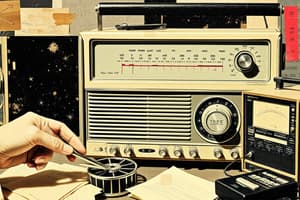Podcast
Questions and Answers
What is the primary limitation of portable radios' range?
What is the primary limitation of portable radios' range?
- The terrain and obstructions in the area
- The power source used to operate the radio
- The wattage of the radio signal transmitted (correct)
- The type of antenna used
What is the main advantage of using a mobile radio over a portable radio?
What is the main advantage of using a mobile radio over a portable radio?
- Portability and convenience
- Increased range due to higher antenna (correct)
- Ability to use repeater sites
- Trunked system capabilities
Why is trunked radio systems important for public safety?
Why is trunked radio systems important for public safety?
- To allow only one agency to use a frequency
- To reduce the number of frequencies used
- To allow multiple users to operate on fewer frequencies (correct)
- To increase the power of the radio signal
What is the primary function of repeater sites in conventional radio systems?
What is the primary function of repeater sites in conventional radio systems?
What is the typical power source for a mobile radio?
What is the typical power source for a mobile radio?
What determines the maximum range of a portable radio?
What determines the maximum range of a portable radio?
What should you do before transmitting on a conventional radio?
What should you do before transmitting on a conventional radio?
What is the primary reason for adjusting the positioning of microphones?
What is the primary reason for adjusting the positioning of microphones?
What does 10-33 code signify?
What does 10-33 code signify?
What is the recommended practice when using a conventional radio repeater system?
What is the recommended practice when using a conventional radio repeater system?
Why is it important to avoid parking too near buildings or under power lines?
Why is it important to avoid parking too near buildings or under power lines?
What does 10-4 code signify?
What does 10-4 code signify?
What is the purpose of the 10-code system?
What is the purpose of the 10-code system?
What should you do when listening to a conversation on a conventional radio?
What should you do when listening to a conversation on a conventional radio?
What is the significance of the 10-12 code?
What is the significance of the 10-12 code?
Why is it important to avoid blocking portable transmissions with your body?
Why is it important to avoid blocking portable transmissions with your body?
What is the main difference between conventional and trunked systems?
What is the main difference between conventional and trunked systems?
What is the first rule of the ABC2 Rules of Radio Transmission?
What is the first rule of the ABC2 Rules of Radio Transmission?
What is the purpose of using the Phonetic Alphabet during radio transmissions?
What is the purpose of using the Phonetic Alphabet during radio transmissions?
What should you do when initiating radio transmissions?
What should you do when initiating radio transmissions?
Why is it important to maintain your composure during highly stressful situations on the radio?
Why is it important to maintain your composure during highly stressful situations on the radio?
What should you avoid when using the radio during emergencies?
What should you avoid when using the radio during emergencies?
Why is plain language important in multi-agency, multijurisdictional events?
Why is plain language important in multi-agency, multijurisdictional events?
How should you hold the microphone during radio transmissions?
How should you hold the microphone during radio transmissions?
What is the correct way to acknowledge radio transmissions directed to you?
What is the correct way to acknowledge radio transmissions directed to you?
What is the purpose of assigning frequencies to each radio in conventional systems?
What is the purpose of assigning frequencies to each radio in conventional systems?
Flashcards are hidden until you start studying
Study Notes
Radio Equipment and Operations
- Portable radios: handheld receiver-transmitters powered by a battery, with a limited range (approximately 1 mile) due to low power and shorter integrated antenna.
- Mobile radios: mounted in a vehicle, powered by the vehicle's battery, with a higher antenna, increasing the effective range.
Trunked Radio Systems
- Allow multiple users to operate on fewer frequencies, assigned to tower sites.
- Importance: efficient use of limited radio spectrum resources.
Conventional Radio Systems
- Use radio-to-radio communication or repeater sites to expand the communication range.
- Repeaters use more powerful radios and taller towers to receive and retransmit signals.
- Conventional systems traditionally use more frequencies, with several frequencies sitting idle for long periods.
ABC2 Rules of Radio Transmission
- A: Accuracy - ensure the message is received without errors.
- B: Brevity - avoid using unnecessary or repetitive words.
- C: Courtesy - respect reflected in tone of voice.
- C2: Clarity - ability to be understood, speaking clearly and concisely.
Improving Transmissions During Emergencies
- Minimize noise around you, avoiding wind noise and screams.
- Maintain composure and keep calm during stressful situations.
- Do not shout, as it can over-modulate the microphone and disrupt communications.
Initiating and Acknowledging Radio Transmissions
- When initiating traffic, state your badge number and the identifier of the person you are contacting.
- Provide your location when initiating contact or when responding to a call.
- Acknowledge radio transmissions by saying "understood", using the appropriate 10-code, or identifying yourself by badge number.
Interoperability and Plain Language
- Use plain language for multi-agency, multi-jurisdictional, and multi-discipline events to improve interoperability.
- Avoid using private codes or terms during these events.
- Language or terms may be unique to one jurisdiction or discipline and may not be common to others.
Phonetic Alphabet
- Used to improve clarity and understanding over the radio.
- Law enforcement in Missouri generally uses the Police (LAPD) Phonetic alphabet.
- Some agencies may use the International (military) alphabet.
Radio/Microphone Techniques
- Position the microphone at a 45-degree angle to avoid picking up breath sounds.
- Hold the microphone one inch from your lips, adjusting for volume and external noise.
- Listen before transmitting to ensure nobody else is talking.
- Think before speaking to avoid dead air or unprofessional transmissions.
- Key (push the talk button) and wait a few seconds before speaking, allowing the electronics to catch up.
- Be aware of the location of your radio antenna and its impact on transmission.
10-Code
- A list of codes used to convey common messages, such as:
- 10-1: poor reception
- 10-2: good reception
- 10-3: stop transmitting
- 10-4: message received, affirmative, ok
- 10-5: relay this information to
- ...and many more
Studying That Suits You
Use AI to generate personalized quizzes and flashcards to suit your learning preferences.





